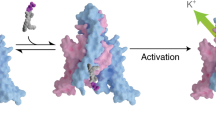Abstract
The effects of toxin II (AaH II) isolated from the scorpion Androtonus australis Hector on sodium current in neuroblastoma X glioma NG 108-15 hybrid cells were analysed under patch clamp conditions in the whole cell configuration. AaH II (70 nM)_induced a maintained sodium current, as well as increasing both fast and slow inactivation time constants and the amplitude of the peak current. This latter effect occurred via a shift of the activation-voltage curve towards negative voltage values by about 9 mV. Oleic acid (5 μM), which had no effect on INa under control conditions, decreased the AaH II-induced maintained current. It also reversed, or prevented the increase of the peak current induced by AaH II. However, it neither prevented nor modified the AaH II-induced increase in inactivation time constants. The binding of the toxin to its specific site and the number of binding sites for AaH II were not significantly modified by oleic acid. The oleic acid-induced effects could not be related to the activation of protein kinase C since PMA, a potent activator of this enzyme, did not produce oleic acid-like effects. From these results, it is concluded that AaH II has several independent effects on sodium channels, some of which could be modulated by the lipid environment of sodium channels in the membrane.
Similar content being viewed by others
References
Benoit E, Dubois JM (1987) Properties of maintained sodium current induced by a toxin from Androctonus scorpion in frog node of Ranvier. J Physiol (London) 383:93–114
Berwald-Netter Y, Martin-Moutot N, Koulakoff A, Couraud F (1981) Na+-channel-associated scorpion toxin receptor sites as probes for neuronal evolution in vivo and in vitro. Proc Natl Acad Sci USA 78:1245–1249
Catterall WA (1979) Binding of scorpion toxin to receptor sites associated with sodium channels in frog muscle. J Gen Physiol 74:375–391
Costa MRC, Catterall WA (1984) Cyclic AMP-dependent phosphorylation of the α subunits of the sodium channel in synaptic nerve ending particles. J Biol Chem 259:7918–7921
Couraud F, Rochat H, Lissitsky S (1978) Binding of scorpion and sea anemone toxins to a common site related to the action potential Na+ ionophore in neuroblastoma cells. Biochem Biophys Res Commun 83:1525–1530
DeLaat SW, Van der Saag PT, Shinitzky M (1977) Microviscosity modulation during the cell cycle of neuroblastoma cells. Proc Natl Acad Sci USA 74:4458–4461
Feller D, Talvenheimo JA, Catterall WA (1985) The sodium channel from rat brain. Reconstitution of voltage-dependent scorpion toxin binding in vesicles of defined lipid composition. J Biol Chem 260:11542–11547
Giraud F, Claret M, Bruckdorfer R, Chailley B (1981) The effects of membrane lipid order and cholesterol on the internal and external cationic sites of the Na−K pump in erythrocytes. Biochim Biophys Acta 647:249–258
Gonoi T, Hille B (1987) Gating of Na channels. Inactivation modifiers discriminate among models. J Gen Physiol 89:253–274
Gonoi T, Hille B, Catterall WA (1984) Voltage clamp analysis of sodium channels in normal and scorpion toxin-resistant neuroblastoma cells. J Neurosci 4:2836–2842
Hamill OP, Marty A, Neher E, Sakmann B, Sigworth FJ (1981) Improved patch- clamp techniques for high-resolution current recording from cells and cell-free membrane patches. Pflügers Arch 391:85–100
Jourdon P, Benoit E, Dubois JM (1986a) Properties of a scorpion toxin-modified Na current. Proceedings IEEE/Eighth Annual conference of the Engineering in Medecine and Biology Society, Forth Worth Texas, pp 958–961
Jourdon P, Berwald-Netter Y, Dubois JM (1986b) Effects of dimethylsulfoxide on membrane currents of neuroblastoma X glioma hybrid cell. Biochim Biophys Acta 856:399–402
Love JA, Saum WR, McGee R (1985) The effects of exposure to exogenous fatty acids and membrane fatty acid modifications on the electrical properties of NG 108-15 cells. Cell Mol Neurobiol 5:333–352
Meves H, Rubly N, Watt DD (1984) Voltage-dependent effect of a scorpion toxin on sodium current inactivation. Pflügers Arch 402:24–33
Moolenaar WH, Spector I (1978) Ionic currents in cultured mouse neuroblastoma cells under voltage-clamp conditions. J Physiol (London) 278:265–286
Murakami K, Routtenberg A (1985) Direct activation of purified protein kinase C by unsaturated fatty acids (oleate and arachidonate) in the absence of phospholipids and Ca2+. FEBS Lett 192:189–193
Naumov AP (1983) Modifications of sodium channels with scorpion toxins and alkaloids. In: Hucho F, Ovachinnikov Y (eds) Toxins as tools in neurochemistry. W de Gruyter, Berlin, pp 13–23
Patlak JB, Ortiz M (1986) Two modes of gating during late Na+ channel currents in frog sartorius muscle. J Gen Physiol 87:305–326
Rack M, Rubly N, Waschow C (1986) Effects of some chemical reagents on sodium current inactivation in myelinated nervefibers of the frog. Biophys J 50:557–564
Schmidtmayer J (1985) Behaviour of chemically modified sodium channels in frog nerve supports a three-state model of inactivation. Pflügers Arch 404:21–28
Takenaka T, Horie H, Hori H (1987) Effect of fatty acid on membrane currents in the squid giant axon. J Membr Biol 95:113–120
Watt DD, Simard JM (1984) Neurotoxic proteins in scorpion venom. J Toxicol-Toxin Rev 3:181–221
Author information
Authors and Affiliations
Rights and permissions
About this article
Cite this article
Jourdon, P., Berwald-Netter, Y., Houzet, E. et al. Effects of toxin II from the scorpion Androctonus australis Hector on sodium current in neuroblastoma cells and their modulation by oleic acid. Eur Biophys J 16, 351–356 (1989). https://doi.org/10.1007/BF00257883
Received:
Accepted:
Issue Date:
DOI: https://doi.org/10.1007/BF00257883




